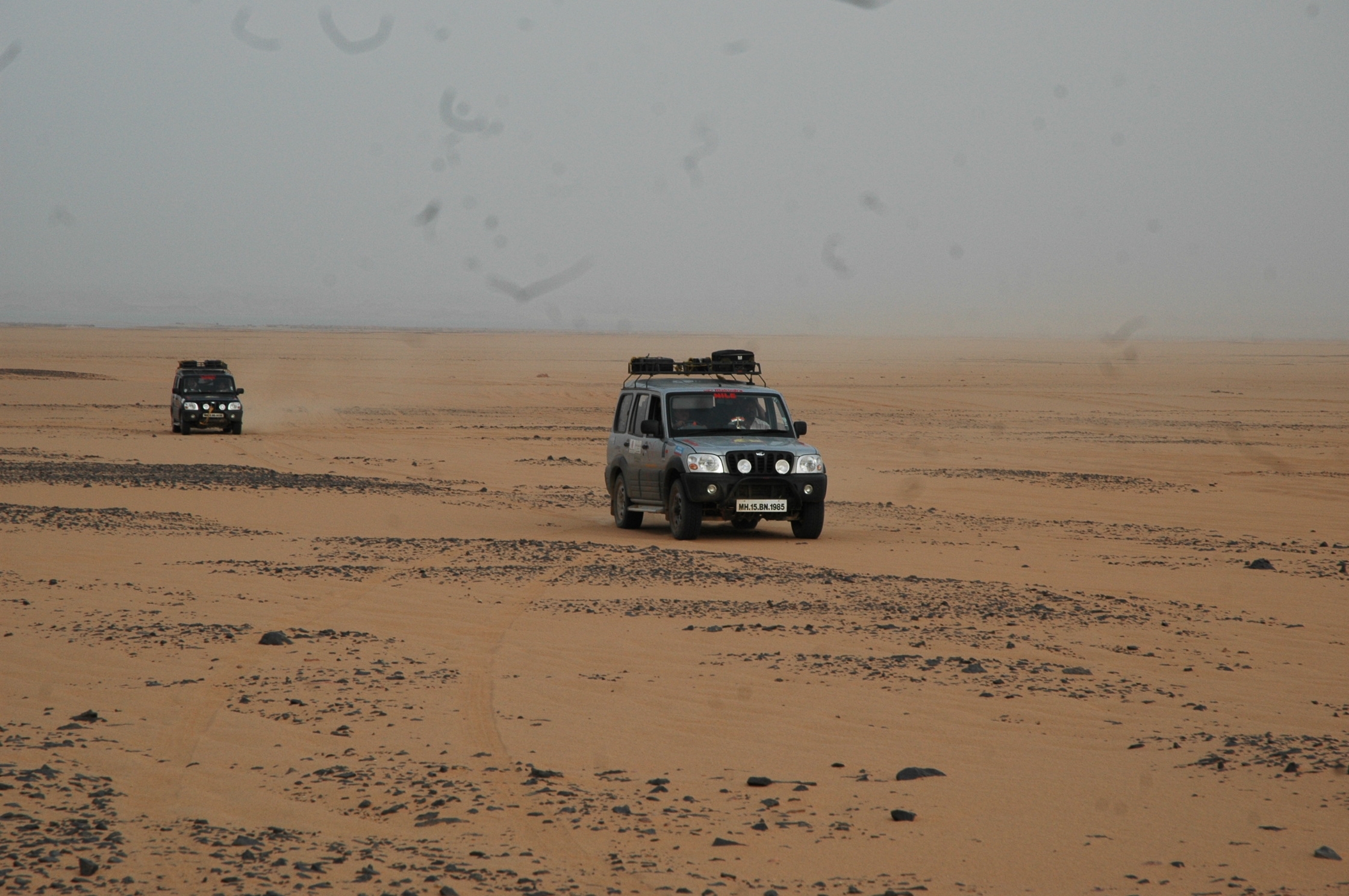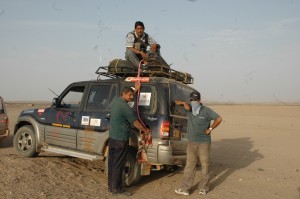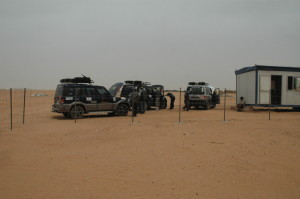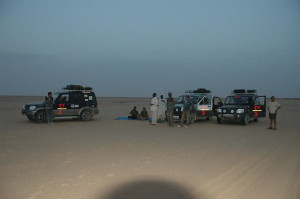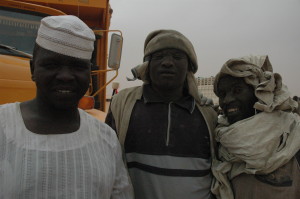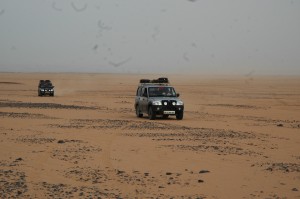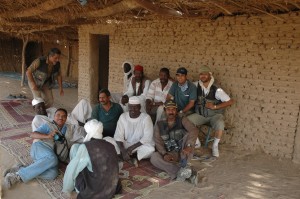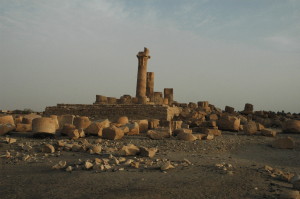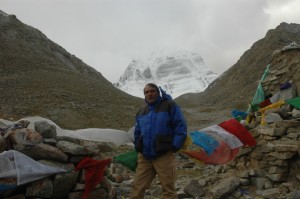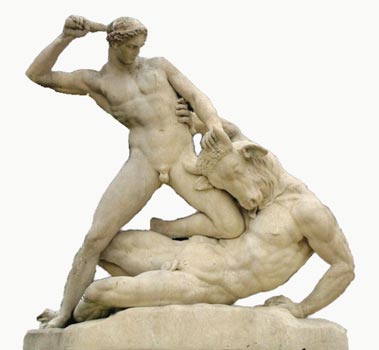In 2006, Akhil Bakshi led the Gondwanaland Expedition, a scientific mission to study earthquake geology and evolutionary history, driving 25,200km from the Indian Himalayas to Cape Agulhus, the southernmost tip of Africa. In this account, extracted from his book Back to Gondwanaland, Akhil narrates the hair-raising experience of driving through the section of the Libyan Desert in Sudan.
“How do you propose to go to Wadi Halfa?” asked Magdy Rabie, the spectacled Liaison Officer assigned to the expedition by the Governorate of Aswan.
“We will drive through the Nubian Desert,” I said confidently.
“But that is impossible. There is no land route to Wadi Halfa.”
That stunned me, knocked me out cold. While planning the Gondwanaland Expedition, the maps I had referred to seemed to show that one could drive from Egypt into Sudan across the Nubian Desert to Wadi Halfa and then continue through the desert, following the railway line and tall marker-poles to Atbara and further to Khartoum. However, this was not the case. Though both Aswan and Wadi Halfa are located on the east bank of the Nile, between them lies the enormous expanse of Lake Nasser in Egypt, the Sudanese portion of which is called Lake Nubia. The vast lake was formed when the Aswan Dam was built. From Aswan, we would be driving on the west bank of the Nile. There is no bridge on the Nile connecting Wadi Halfa to the west bank. I had shared our proposed route with the Egyptian Embassy in Delhi, the Indian Embassy in Cairo, which in turn had informed the Egyptian Foreign Ministry – but no one had noticed the blunder.
“The only way you can go to Wadi Halfa is by the weekly steamer across Lake Nasser,” said Magdy, noticing my body turn into a glacier.
We hurried to meet the Director of the shipping company. He wasn’t certain when the steamer would dock in Aswan. “May be in two or three days,” he said, tentatively. “But the steamer can only carry passengers, not your vehicles.” The ground opened under my feet. I had that sinking feeling. I pulled myself up, trying to come to terms with the seemingly hopeless situation. Would this mean the end of the expedition? Could an airlift be arranged? Should we return to Luxor and drive east to the Red Sea coast and try entering Sudan from there – hitting Port Sudan?
“Is there a solution?” I asked the shipping agent.
“I could look for a barge that could haul your vehicles. The steamer could tow the barge.” He quoted an astronomical price for the service. “Come back to me tomorrow and I will tell you if it is possible. Meanwhile, I will keep your seats on hold.” From Aswan to Wadi Halfa was a three-day sail. If we chose the steamer-barge option, our schedule would be set back by a week, throwing all our meetings and hotel bookings irretrievably out of gear.
Taking pity on my fallen, ashen face, Magdy, trying to raise my spirit, said: “There is one possibility, but very slim. You can cross from the unused Argine border post into Sudan. After that it is only desert – not the Nubian, but the Libyan. No roads. No tracks. The entire area is under the control of the military. If they allow you, you can go.”He arranged an appointment with the major-general of the military intelligence unit under whose command the entire area fell. We walked into a morbid, joyless room, its walls plastered with huge maps. The meeting with the general began mysteriously and ended in failure. He and Magdy spoke in Arabic, cordially at first but by and by, the general’s face became red as his temper rose and he started giving the deadpan Magdy mouthfuls. After hurriedly downing a cup of green tea, the general dismissed the hapless Magdy and ushered me out with a smile and a handshake.
Ignoring the rebukes hurled at him, Magdy explained the general’s viewpoint. “He says he will be thrown out of his job if he gives you permission to cross from Argine. The authorisation can only come from the Army Headquarters in Cairo.”
I called the Indian Embassy in Cairo and requested their intervention. They informed me that, in accordance with the protocol, they could not contact the Egyptian Army directly but could only do so through the Egyptian Foreign Ministry. Moreover, they would have to take the Ambassador’s sanction – and he was out of town. Tomorrow, Friday, was a holiday followed by the weekend. The earliest they could move the foreign ministry would be on Monday – after three days. When troubles come, they descend together. After a little persuasion by Magdy and myself, the Deputy Chief of Mission agreed to shoot off a fax to the foreign ministry and the Defence Attaché spoke to his counterpart in the Army Headquarters informing him that the request seeking permission for the expedition to cross from Argine was on its way.
“Tomorrow you will be meeting the Governor of Giza. He is a retired army officer. A major-general. Commando. You tell him about your problem. Perhaps he can help since this area comes under him,” advised Magdy.
General Sameer Yousuf had specially come to his office on a holiday to receive us. After the usual introductions, I told the pleasant governor that most of the expedition members came from martial families. Two of my uncles had fought in Palestine during the Second World War. Vikram Gill’s grandfather had fought in Egypt during the First World War. Then I told the general about the mess we were in. His response was immediate and positive. He would personally talk to Cairo and make sure that the permission came through – by tomorrow. He just wanted a copy of the letter that was faxed by the Indian Embassy to the Foreign Ministry. Meanwhile, he advised, we should visit the many interesting sites in and around Aswan, specially the unfinished obelisk. Our hopes revived, we pushed further south towards the Sudanese border, to Abu Simbel, visiting the Aswan High Dam enroute.
***
Do you know what you are doing?” asked, in broken English, the young and handsome Major Hussaim, the head of border intelligence, escorting us to the Argine checkpost. “There is nothing, nothing on the Sudanese side. No road. No track. Just sand.”
“How much sand?” I enquired.
“Too much.”
“Like here?” I asked, pointing to the sandy terrain we were driving through.
“Much more. This is nothing. You will sink. Very very difficult.”
The major was sweaty, nervous and chain-smoking as he sat besides me in the Nile. He was clearly concerned about our prospects.
“I don’t think you can do this. It is impossible,” he continued, disturbing my confidence. “I know. I have been here in the desert for more than three years.”
“But I am told that Sudanese trucks ply on the route, picking up cement from the Argine border?”
“Sure. Once or twice a week. And that too sometimes. But those are huge, powerful trucks. They can take on the sand if they get stuck. You have nothing. One of your jeeps is two-wheel-drive. You will not make it.” Though I was getting a bit uneasy, my endorphin rush had not yet completely receded. I had been looking forward to this adventure in the sands of Nubia.
“Is there somebody waiting for you on the Sudanese side? What if we do not find anybody? What will you do? Where will you go? There are no signs or markers,” continued the major, almost pleading with me to do a reality check. “Insha-allah, the weather now is good. But if a haboob, a storm, comes, you will have it. The desert will tremble. The dunes will shiver and shift. Horizon disappears. You will get disoriented. Dust will choke your lungs. Entire caravans and even armies have perished in the desert.”
In between his honest attempts to scare me, he made calls from his cellphone and spoke frantically in Arabic.
“You have enough water?”
“We have enough, I think,” I replied, unsure of myself.
“If you are stuck in the desert without water, you will be dead within two days,” said the prophet of doom. “You lose ten litres of water a day even if you are not sweating. It has to be replaced at once. So keep drinking.”
“What happens to the body if we run out of water?”
“In less than a day your brain will become confused and speech will ramble. Strange visions flood the mind. Next day the fever comes followed by death.”
The Argine post is 150km from Abu Simbel. At Tokshey, 50km from Abu Simbel, we met up with the delegation of officials that had left from Aswan early in the morning. We got off the main road and took detours along the massive Toskha Canal that was under construction. Acclaimed as an engineering feat on par with the Aswan Dam, the dream canal, when complete by 2017, will suck water straight from Lake Nasser and send it on a 500 km journey, linking a string of oases in the Western desert, putting more than 600,000 new hectares under the plough, creating a parallel Nile Valley.
“A Saudi prince has already bought 100,000 acres at E£50 ($14) an acre to grow produce for a chain of supermarkets in the kingdom,” said Major Hussaim. “Two new cities and several industrial zones will be built. Millions of people will get jobs.”
About 35km from the border, my vehicle lost power and stalled. Sudhir, our vehicle engineer, was under the vehicle for two hours in scorching heat, lying on a mat over the melting tar, trying to fix the problem. The diesel I had bought in Luxor was bad and its sediments were choking the fuel supply system. He fiddled around with the system, replacing part after part without success. Just when he was about the give up, the driver of the mini-bus that had brought the officials from Aswan suggested to Sudhir to make a “direct” connection. Immediately, Sudhir went to work on that option. It meant keeping a jerry can of diesel next to the driver seat and supplying the fuel directly to the engine. Though Sudhir made an attempt, he did not have a pipe of the required size. I suggested that the party from Aswan move ahead to the border and request the Sudanese officials, if they were there, to wait for us. Meanwhile, we would return to Abu Simbel, 115km away, look for a pipe and return after fixing the problem. To keep the flock together, all the three expedition Scorpios would drive back. As we packed the toolkit, the mini-bus driver suggested to Sudhir to try changing the fuel filter. Sudhir jumped on the idea and replaced the filter. The engine started at once and, with a deep sense of relief, we left for the border.
Close to the border, the road degenerated into a trail. At the border the trail disappeared completely. Beyond the collapsing border fence was a sea of sand, endless, lonely, featureless. Four massive trucks were parked on both sides of the border, carrying cement from Egypt and transferring it to the trucks waiting on the Sudanese side. A Sudanese army officer stepped across to greet us. After the Egyptians had stamped us out and we readied to leave, Major Hussaim gave me a hug and said: “This is first time any foreigner has been allowed to cross the border from here and that too in their own vehicles. You have made history.”
***
On all sides the flat, boundless, sandy world stretched away into the horizon. The voluminous National Geographic Atlas of Africa, with details of all roads and tracks on the continent, was blank and empty for this desolate expanse of Sudan, an extreme wilderness not worth exploring. A solitary, weather-beaten porta-cabin made up the Sudanese Customs Office. While one person struggled with our passports, another searched our Scorpios. Making a cursory examination of our baggage, the customs officer devoted his energies to listening to each and every music CD in our vehicles. After suffering classical Indian vocalists, Pandit Jasraj and Bhimsen Joshi, for a long while, he heard the rest of the CDs in fast-forward. It took the Sudanese three hours to go over our documents. Meanwhile, I made friends with the rough-looking loaders. Every crack and crevice in their black faces was filled with cement and sand.
Escorted by a Customs Land Cruiser, we were led to Argine Village, 9km away, to register once again with the authorities. Hardly had we gone 500 metres, when two of our vehicles, named Nile and Tigris, sank in the loose sand. The Land Cruiser towed us out and, in doing so, crashed into Tigris, damaging its rear door and lights. Slowly, we learnt the art of driving in the Libyan Desert: stay away from the deep tracks made by the heavy trucks; drive on the smooth desert surface, which is crustier.
Argine village, by the Nile, comprised of a couple of low mud-brick houses hidden behind compound walls. A thatched shack served as the Immigration Office. Wiry Nubians, attired in white turbans and long robes, or jelabia, their traditional dress, grouped themselves on their haunches and squatted here and there on sand. We topped up the tanks, buying gallons of diesel in plastic containers and transferring it manually through pipes. The tyre pressure was reduced for better traction. A slender, malnutritioned donkey, pulling an empty cart, stopped to take a look at our Scorpios. A common blue pigeon strutted behind a black-spotted bird. Seeing desolation all around, I asked the immigration officer if his Land Cruiser could escort us to Dongola. Not possible, he said. I then requested him to help us hire a trustworthy guide who could lead us through the desert at night. Immediately, he produced one and I hired him. The guide spoke no English and we no Arabic and the communication problem would soon lead us into trouble.
To decide on the route to take, we sought the help of a man who spoke fluent English. He had earlier approached our team-mate Vikram, seeking condoms. “I have four wives and always seem to run out of these things,” he had complained, smiling. The cement trucks had preceded us to the village. They all had perforated steel planks, toles, fixed to the sides of their body. These were vital for getting out of soft sand. There were two routes to Dongola. The regular route was along the Nile with a few sparsely populated habitations. The entire stretch was sandy and, in the opinion of a truck driver, perhaps a bit difficult for our vehicles to negotiate. However, if we got stuck, food and help could be at hand. The alternative was to take the route used by the heavy cement trucks. This was 50km inside the desert, away from the river, less sandy, a wind-scoured hardened surface carpeted with gravel and rock that were too heavy for the wind to carry. The disadvantage was that for the first 300km the route was devoid of life and we could not expect any assistance in case of trouble. Well stocked with food and water, I preferred the interior route. As the cement trucks were leaving the same time as us, I requested one of them to stay on our rear and bail us out if we got bogged in sand. As the glare of the day mellowed into twilight, we left with our hearts in our mouths.
It turned out that the “guide” was a Customs official wanting to hitchhike to his village in the outskirts of Dongola, our destination, about 450km away, where we would get out of the desert and meet the road to Khartoum. About two kilometres from the village, Sudhir, over-enthusiastic and over-confident, driving Ganga, the 2-wheel Scorpio, broke the formation, trying to find his own route, and got badly stuck in the sand. We waited for the trucks to arrive to bail him out. A convoy of four trucks went past us without paying any heed to our frantic waving of hands. We suddenly felt abandoned and bereft. A long while later the last truck, the one we had made arrangements with, came by and stopped a long distance away. A man, barefoot and in a soiled white robe, plodded towards us. Seeing the miserable state of the vehicle he nodded his head and signalled to the truck seeking further support. A boy brought a shovel and all of us went on our hands and knees getting the sand out from under the vehicle. Clearing the sand, we would heave and ho the vehicle but it kept sinking, the turning wheels just digging themselves in. It was a laborious work. Slowly, inch by little inch, we got the vehicle out. It took over an hour. Darkness had slowly set in. Two hundred metres later, climbing over a sand mount, with me in the lead and the guide beside me, we rolled down into a sandy track, visible only on the descent. Before I could register what the guide was shouting in Arabic (he was asking me to stay on the right), it was too late. I drove straight into the track and sank into the soft sand. Tigris, the Scorpio following me, also got stuck.
Some of the expedition members were by now clearly unnerved and terror-stricken. One suggested, tremulously, that we hire trucks to tow the Scorpios through the desert. Another braveheart was of the opinion that towing might damage the vehicles and we should somehow load the vehicles on to trucks to ensure any chance of getting through the desert at all. I had more faith in the ruggedness of our Scorpios and reasoned with them that the vehicles were stuck because of our own fault and inexperience and not due to their inability to negotiate the difficult terrain.
Luckily, the truck driver, “Farishta”, or Angel, the name we gave him later, saw us and again came to our rescue. Again shovels were brought out and sand removed. The experienced Farishta, taking over the steering, applying his own tried and tested techniques, using minimum clutch and acceleration, had the vehicles out in no time. He would gun the motor, slip the clutch and the vehicle would leap forward by an inch or two. He kept repeating the process till the vehicle got onto harder sand. I hired him for the journey as the expedition leader, handing him my lead vehicle, Nile, and shifted the “guide” to Tigris. Freed from driving and trying to understand the incomprehensible instructions of the guide, I could monitor, in total darkness, the movements of the other two Scorpios and give them clear directions over the communication sets.
With Farishta on board, we breezed through the desert like the wind. He seemed to know every grain of sand in the desert. On that dark, moonless night how he found the way through the flat desert that had no defined trail, no signpost, landmarks, or vegetation to guide us, remains a mystery. We concluded that this illiterate man must have a GPS in his head. Gopi, the expedition zoologist, had a GPS and he himself was baffled: sometimes we were heading east, sometimes west and sometimes south. He did not know what to make of it. Farishta was obviously driving in a wide arc to avoid getting bogged down in sand. With Ganga and Tigris in hot pursuit, Nile flew over rocks and gravel, swerving left and right, and into long stretches of low sand, blowing clouds of dust, rattling every nut and bolt. Thankfully, the notorious Saharan wind system was at rest. Everything was still.
At about 1 a.m. Nile and Tigris again sank together in sand and Farishta smilingly took them out. Ganga, while waiting for us, noticed it had a flat tyre. It was changed after a lot of hard work because the jack kept sinking into the sand every time we tried to raise it. Just as we started moving, I heard some horrible screeching sounds from my left wheel. They would come and go. Sudhir, tested for the first time on the expedition and tired after labouring all day, told me to ignore the problem. At night, too, the desert has mirages. Illusive village lamps lure the ignorant deeper into empty terrain. Abu Lamba, father of lights, they are called in Arabic.
Farishta spotted a lone truck parked in the desert. He drove towards it, crunching to a stop some distance away on a firm section of the desert floor. The two of us walked to the truck to investigate. Farishta called out, but no one responded. We climbed the back of the truck to see what it contained. Big, shiny eyes stared back at us. Camels sat quietly, huddled together. A goatskin bag, half filled with water, was slung from the side of the truck. Farishta had his fill, emptying it. It was the desert way. If you see someone in the desert, alone or in a group, you stop. There may be “water need”. Similarly, if someone shows up at your tent or encampment needing water, it is your obligation to provide it.
The noise from Nile’s left front wheel kept increasing. Sudhir finally opened the wheel and found small stones stuck between the wheel plates. As we were fixing the problem, Farishta lay down on the desert floor and fell asleep instantly. I let him snooze for 45 minutes before shaking him out of his slumber. Protesting, Farishta took the wheel and drove hard and rash, abusing the vehicle. Within 15 minutes he stopped, indicating that he was extremely drowsy and could not press on. As his vast frame hit the sand, he fell into deep sleep. Most of us also had heavy eyelids and took the opportunity to take a nap. The air had cooled. At four in the morning, the sky filled up with stars and we had them all to ourselves. It seemed that time had stopped and we were the last people remaining on earth. There was pin-drop silence in the desert. There was not a sigh in the wind. Not a grain of sand moved. Nature was at repose. I slumbered soundly in the front seat of Nile. At about 5.30 a.m., I was woken up by the groan of four huge trucks, driving side-by-side, rumbling towards us, kicking up clouds of sand. The excessively tall and lanky Nubians stopped to exchange pleasantries with Farishta and made instant friends with us, giving warm Islamic embraces. I climbed up one of their Hino 700 trucks to see what they were transporting. Again: camels for the Egyptian meat market. At the Argine border they would transfer the load to the Egyptian trucks bringing in the cement. In Egypt, camel meat is cheaper than mutton and the same price as beef.
After Farishta and the guide had offered namaz, whispering words of prayers towards Mecca, we hit the sand again, catching the sunrise over the vagrant hills in the Libyan Desert. In a hurry to scorch the land, the sun shot up in minutes. In full light, the treeless, shadeless desert looked more forbidding, hostile and frightening than it had seemed in the dark. The parched world of sand, boulders and rocky outcroppings was littered with sand-blasted skeletons of camels who could not survive the long march to the Egyptian border. On all sides it was one prodigious graveyard. These days the camels are taken to the market in the comfort of trucks.
Around 8 in the morning, after driving 330 km across the desert, we came across the first habitation – a small village by the Nile. We halted by the crumbled ruins of an ancient Egyptian temple that may have been majestic once but is anaemic now. Monstrous columns and immense slabs of stones lay around, unprotected. Some fragments of magnificently carved pillars are still standing. I did not know it then but know now, as I write, comparing photographs I had taken of the ruins with those in a coffee table book on Sudan, that this was the village of Soleb and these ruins were of the temple of Amenhotep III (1370 BC), celebrating the Egyptian conquest of the region. As I wandered through the melancholic ruins a playful baby goat scampered towards me and showered me with its affection. The kid felt like a soulmate from a past life. Donkeys grazed in the harvested millet fields. Piles of dusty straw were heaped in front of brown mud houses. A lush grove of affluent palm trees indicated a narrow fertile strip on the nearby bank of the Nile. Three ragged kids ran to meet us and took away our empty plastic bottles and leftover food. Like all Sudanese villages we would pass later that day, Soleb seemed like a ghost village, its population keeping itself indoors during the day. A bee-eater sitting on a neem tree watched us top up our empty tanks with reserve fuel stocked in jerry cans.
On the outskirts of the village was a ramshackle teashop that Farishta could not resist. Its walls were made of mud-brick and dried palm fronds. In the tidy kitchen, millet bread was being readied for baking in the gas-fired oven built deep inside a wall. While the tea brewed, we sat hunched together with a couple of Nubian men robed in their jelabia. Some wore a skullcap, another a red Fez, while others veiled their pitch-black faces with turbans, exposing only their reddened eyes. Born and raised on a diet of sand, they seemed a hardy lot – tall, muscular, and with a regal stateliness of bearing. Glad to have come out of the dark night unthreatened, I ordered tea for all of them. We downed copious quantities of karkade, a cranberry-coloured brew made from hibiscus flowers and garnished liberally with sand. Gritting my teeth, I bid them a fond farewell.
Leaving the hot and dusty village we again entered the bleak, smileless desert, counting kilometres and hours to get out of it. The fuel pump of my Scorpio, Nile, started giving trouble again. The sediments from the bad fuel choked it over and over and every time the vehicle stalled convulsively we would open the baked bonnet, pump the plunger a hundred times or so till the engine ignited. The crippled vehicle would limp till it ceased again – which kept happening every 8-10 km – prolonging and frustrating our date with the Libyan Desert. Sun-flames shot down like shafts of fire and the heat radiating back from the earth grilled us every time we stepped out. Tigris’s air-conditioner had been kaput since Luxor and its stifled occupants bore the brunt of the blistering weather.
At the next village, accessed through a most treacherous route across steep, unstable cliffs and boulder-strewn hills, Farishta stopped for lunch. Swarms of buzzing flies were holding a conference on the bloody cow meat hanging from the ceiling. Inside the filthy kitchen lay smelly innards of the beast. All of us passed the meal opting, instead, for the local carbonated drink cooled in a bucket of Nile water. As the lunch took a long time coming, Sudhir laid out his blue tarpaulin on the dirt floor and, along with some of the other drowsy teammates, got an hour of refreshing sleep.
Closer to Dongola, palm-fringed villages became more frequent and their size bigger. Tamarind and neem trees provided the shade. Partridges and sandgrouse shuffled in and out of bushes. At the entrance of every village huge earthen pitchers filled with water were placed in shade for passersby. Some of the villages had an unpretentious qubba, a conical mud structure that holds the remains of an illustrious Islamic holy man, who, I presume, was also virtuous. The mud walls of several houses were painted with simple geometric designs. Women wrapped in brightly coloured tobe that resembles the Indian sari, walked erect carrying headloads, every step exposing the decorative henna on their ankles. Chaotic Indian-made Bajaj three-wheeler scooter taxis plied through cultivated fields, creating a ruckus. By the time we hit the tarmac road on the outskirts of Dongola, it was five in the evening. The grateful vision of the road drew mighty cheers from the bleary-eyed and weary adventurers. Since leaving Abu Simbel, the expedition had driven hard and diligently for 33 exciting hours.
Akhil Bakshi is a born tramp in love with wild places, Akhil Bakshi has been vagabonding around the world since his early years, finding telling beauty everywhere. He has led four major international motoring expeditions that have furthered the cause of peace and development. Vice President of the Indian Mountaineering Foundation, Fellow of the Royal Geographical Society, Fellow of the Explorer’s Club, he is on the board of several adventure and sports organisations in India. He has founded two non-government organisations that work with rural youth and with small farmers and landless labour.
Akhil Bakshi has produced seventy television documentaries. His books include: The Road to Freedom; Silk Road on Wheels; Between Heaven and Hell; Back to Gondwanaland; I’ll Follow the Sun and Askar Akaev – A Political Journey.
